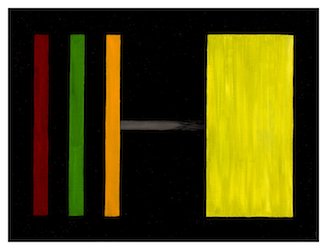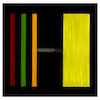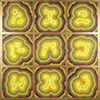|
A DREAM OF STARS AND LIFE, PART 3
By PHILIP ANDERSSEN Published: Wednesday, 12 December 2012 |
|

. . .
Why would Vincent Van Gogh paint such a representation that has no parallel in the paintings of that same time? Why the moon-sun, the coiling nebula, the stars, the cypress tree, the church? This is the quest that we must undertake; to try to reach to Van Gogh’s mind and discover the raison d’etre of this painting, putting aside what our minds would like it to be. But we have to be extremely cautious here. It is simple enough to let the mind go free into alien visions, but if what we desire is true interpretation we have to put aside what is evoked in our thirsty and imaginative minds and look for facts: how do we go about interpreting this painting? The answer is to start by taking a closer look at our artist.
“Someone who passed through Saint-Rémy at that time told a story about a red-haired painter, who sat there and covered canvases with thick colors, while another lunatic sat near him and scratched the paint from the pictures” (Meier-Graefe 186). It was in 1888 that Vincent Van Gogh moved to an asylum at Saint-Rémy because of the effects of a terrible illness that had surprised him in the city of Arles: he was “subject to infrequent epileptic fits and acute mania,” as Philip Callow tells us (247). Callow narrates:
From now till his death he would be assailed by the fear that he was losing control of his actions, his brain treacherous, flashing across with wild jolts of contradictory messages. … It must be like losing grip on one’s memory in the prime of life, only much, much worse. He might do anything, wander anywhere, become the prey of any vile thought… He was in a process of inner disintegration that he was forced to witness, isolated as never before.
It is maybe this brief perception of his life that can give us the first glimpses of the true understanding of “The Starry Night.” Vincent suffered, and he was conscious of his suffering, perhaps too much, but he was also conscious that he didn’t have the power to succeed over his illness.
It was during this time as well, around June of 1889, that Vincent “made the discovery of the cypress tree” (Meier-Graefe 189). He tells this to his brother Theo in one of his letters:
“The cypresses are always occupying my thoughts, I should like to make something of them like the canvas of the sunflowers, because it astonishes me that they have not yet been done as I see them. It is as beautiful of line and proportion as an Egyptian obelisk. And the green has the quality of such distinction. It is a splash of black in a sunny landscape, but it is one of the most interesting black notes, and the most difficult to hit off exactly that I can imagine” (Letter 596).
The cypress tree was a very unexpected discovery for Van Gogh, but he obviously found in it a way of transforming his emotions. As he says to Theo, he painted the cypress tree in a way that hadn’t been done before; he was establishing his conventions, his rules, making of this particular image of a tree a symbol of sorrow and suffering for him. The cypress has traditionally been associated with graveyards, death symbols for Van Gogh, but according to Callow, they also took on additional meaning by exteriorizing Vincent’s turbulence and fears (250). In Greek mythology, Cyparissus, Apollo’s beloved, received from Apollo a sacred deer as a love token. However, one day, Cyparissus threw his javelin and it by chance hit and killed the deer. Cyparissus’s sorrow was so great that he asked Apollo to let his tears fall for all eternity. Apollo then transformed the boy into a tree, the cypress, which became the symbol of sorrow. Vincent found in the cypress a similar means to express his suffering. But the cypress tree is only one element, which luckily for interpretation was very easily identified with an already established convention. What has, however, more significant implications for us depends rather on what is not conventional. . .
Callow, Philip. “Chapter 12: Asylum.” Vincent Van Gogh, A life. Ed. Ivan R. Dee, Inc. Chicago, 1990. 239-262.
Meier-Graefe, Julius. “The Cloister of Saint-Rémy.” Vincent Van Gogh, A Biographical Study. Ed. Greenwood Press, Publishers. Westport, Connecticut, 1970. 186-211.
Van Gogh, Vincent. Letters 593, 594, 595 and 596. The Complete letters of Vincent Van Gogh, Volume three. Ed. Bullfinch Press. Toronto. 1991. 176-186.
comments powered by Disqus
| RELATED ARTICLES | |||||||||||
|
|
|
|
||||||||


